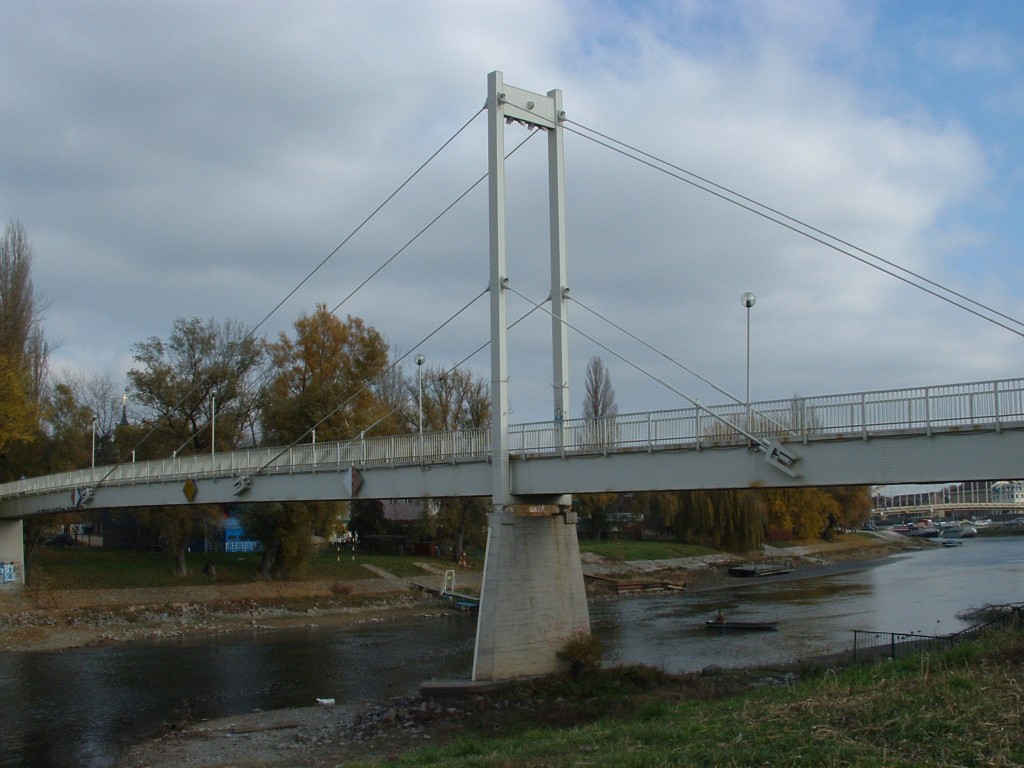A Vásárhelyi Pál gyalogoshíd, ismertebb nevén „Kis Erzsébet- / Kisbözske – híd” 1969-ben épült meg, és 2010-ig kötötte össze Révfalut és Győr-Sziget városrészt. Ekkor helyére közúti híd került. Itt haladt a Szigetközből Győrbe irányuló forgalom jelentős része, de 1888-ig csak kompjárat működött. Ekkor a győri kereskedők nyomására, akik már 1860 körül is állandó híd megépítését sürgették, elkészült az első épített átkelő, a „tízlábú” fahíd.
Győr városvezetése a hatvanas években aztán jelentős fejlesztéseket tervezett Révfaluba. A falusias beépítésű terület folyóparti része alkalmasnak tűnt egy magasházas lakótelep elhelyezésére. Ez végül elmaradt, helyette 1971 és 1977 között megépült a Széchenyi István Egyetem jogelőd intézménye, a győri Közlekedési és Távközlési Műszaki Főiskola.
A híd több szempontból is egyedi és a győrieknek is kedves volt. Nem csak a formai hasonlóság miatt becézték “Kisböské”-nek, hanem mert (takarékossági okokból) a budapesti Erzsébet híd kábelanyagának maradékából készült, így valóban annak “kistestvére”.
Győr városa aztán 2010-ben megvalósította Révfalu és Sziget állandó, gépkocsiforgalom számára is alkalmas összekötését. Ennek azonban a gyalogoshíd áldozatul esett. Azóta egykori helye mellett, a révfalui oldalon “eltemetve” áll önmaga emlékműve.
Forrás: moderngyor.com
//
The Pál Vásárhelyi pedestrian bridge, known to most as „Erzsébet Kis- /Kisbözske-bridge” was built in 1969, and connected the Révfalu and Győr-Sziget districts until 2010. Then, it was replaced with a road bridge. It was on this route, where most of the traffic was going through, headed from Szigetköz to Győr, but until 1888 the passengers could only take a ferry ride here. After the pressure coming from the merchants of Győr, – who already urged the city to build a bridge from they year 1860 – the first crossing place was built, the „ten-legged” wooden bridge.
The city management of Győr then started to implement major developements in Révfalu. The river banks of the village-like area seemed ideal to locate a high-rise apartment complex here. Then, instead of the apartment complex, between 1971 and 1977, the legal predecessor of the Széchenyi István University, the Transportation and Telecommunication Faculty of Technical Sciences had been built.
The bridge was unique and dear for the people of Győr for many reasons. Not only was it called ”Kisböske”, because of its similarity in shape, but (for economic reasons) also it was made from the remainings of the cable materials of the Erzsébet bridge in Budapest, so it really is the „little sibling” of the latter.
The city of Győr then achieved the connection between the Révfalu and Sziget districts in 2010, which is suitable for car trafiic as well. For this to be possible, the pedestrian bridge paid the price. Since then, next to its former place, it’s own memorial is standing ”buried”, on the side of Révfalu.
Source: moderngyor.com

A „Kisbözske-híd” akkor // Kisbözske-bridge” then
Fotó: SZE

A Jedlik – híd most // Jedlik-bridge now
Fotó: Májer Csaba József

Már csak emlék… // It’s just a memory…
Fotó: HG






